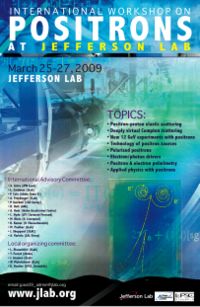Difference between revisions of "JPOS09"
| (3 intermediate revisions by the same user not shown) | |||
| Line 63: | Line 63: | ||
==Session 3== | ==Session 3== | ||
| − | Session three focused on | + | Session three focused on positron sources developed at several institutions and the transference of those experiences towards the design of a positron source at JLab for the CEBAF. The first contribution to the session provided an overview of the three standard positron production techniques; conventional, undulator, and laser compton. The second contributor reported on the performance of a polarized positron source tested at SLAC which observed positrons polarized up to 80%. The next contributor described a possible CEBAF positron source design based upon the experiences of SLAC and the Cornell Positron Source. The final two contributions to the session presented descriptions of positron sources based on lower energy, MeV, incident electron beams. The performance of a positron source using a 20 MeV linac at ANL was described and it was predicted that the highest efficiency for producing thermal positrons would occur for incident electron energies between 40 an 60 MeV. The session ended with a description of a polarized source using a 5.5 MeV linac which anticipates producing an 80 nA positron beam. |
Latest revision as of 16:14, 9 June 2009
http://conferences.jlab.org/JPOS09/
Positron_Workshop_2009 : March 25-27, 2009
Foreword
Below we would like to write up an introduction to the JPOS09 proceedings. We need 1 paragraph on the nuclear physics using GeV positrons and one paragraph on thermal positron uses. A paragraph reviewing other positron sources and their capabilities. A paragraph identifying the more promising methods for positron production with CEBAF and an estimate of the beam properties.
Wed 3/25/09
2 exchange
looking for positron currents of 1 A in Hall C or 100 nA in Hall B.
Positron production
Energy options
At > 50 GeV incident electron energies, an undulator can be used to generate MeV energy photons which pair produce in a target. You get about 200 photons for each incident electron?
At between 1 and 50 GeV, back scattered compton photons may be the optimal choice for producing positrons.
The conventional method of using a converter target my be the best choice for incident electron energies less than 1 GeV.
The undulator and compton techniques create polarized photons and then polarized positrons. For the conventional method you could use off axis bremmstrahlung to create linear photons or polarize the incident electrons and have the polarization transfer.
Thermal energy production
Sergey Chemerisov was able to capture 100 more transmitted positrons (positrons emitted on the same side of the target as the incoming electron beam) than reflected positrons at 20 MeV incident electron energies.
Thermal positron rates of e+/sec
Converter target choice
Alexander Mikhailichenko suggested using liquid Bismuth as the converter target and a high current incident electron beam ( mA). The target would need to handle 50 MW of power. You may get one positron for 500 incident electrons.
Target is 55.51% Bi and 44.49 % Pb by mass and is liquid at 159.5 C.
The loop needs to be Ti (melting point 1668 C).
Polarimetry
P. Schuller (DESY) has the iron block used in E-166 at SLAC for the compton transmission polarimeter. The incident photon Energy went up to 8 MeV.
We could measure positron polarization by measuring the polarization of photons from the positron annihilation. Compton scattering depends on the polarization of the struck atomic electrons. An external B-field will polarize the FE block. You can either flip the direction of the B-file or the direction of the incident photon polarization to measure the photon polarization.
The IAC could make a compton transmission polarimeter to use on the photo-fission experiment as well as a proto-type for JLab.
Thermal positrons
How big is the user thermal positron user community?
Need to organize the community, perhaps write a 5 year long range plan, then present plan to JLab management and then DOE.
Proceedings
Session 3
Session three focused on positron sources developed at several institutions and the transference of those experiences towards the design of a positron source at JLab for the CEBAF. The first contribution to the session provided an overview of the three standard positron production techniques; conventional, undulator, and laser compton. The second contributor reported on the performance of a polarized positron source tested at SLAC which observed positrons polarized up to 80%. The next contributor described a possible CEBAF positron source design based upon the experiences of SLAC and the Cornell Positron Source. The final two contributions to the session presented descriptions of positron sources based on lower energy, MeV, incident electron beams. The performance of a positron source using a 20 MeV linac at ANL was described and it was predicted that the highest efficiency for producing thermal positrons would occur for incident electron energies between 40 an 60 MeV. The session ended with a description of a polarized source using a 5.5 MeV linac which anticipates producing an 80 nA positron beam.
| Topic | speaker | talk | edited talk |
| Positron Development for Accelerators and Colliders | Wei Gai, Argonne National Lab wg@hep.anl.gov | File:WeiGai JPOS09.doc | File:WeiGai JPOS09 Edited.doc |
| Polarized Positrons & Polarimetry | Peter Schuler, DESY Peter.Schuler@desy.de | File:PeterSchuler JPOS09.doc | File:PeterSchuler JPOS09 Edited.doc |
| High Power Target and Collection Optics for Positron Production | Alexander Mikhailichenko, Cornell University aam10@cornell.edu | File:Alexander Mikhailichenko JPOS09.doc | File:Alexander Mikhailichenko JPOS09 Edited.doc |
| Generation of high intensity beam of thermal positrons using 20 MeV electron linac | Sergey Chemerisov, Argonne National Lab chemerisov@anl.gov | File:Sergey Chemerisov JPOS09.doc | File:Sergey Chemerisov JPOS09 Edited.doc |
| Positron production at CEA/Saclay | Yves Sacquin, Saclay yves.sacquin@cea.fr | File:Yves Sacquin JPOS09.doc | File:Yves Sacquin JPOS09 Edit.doc |
